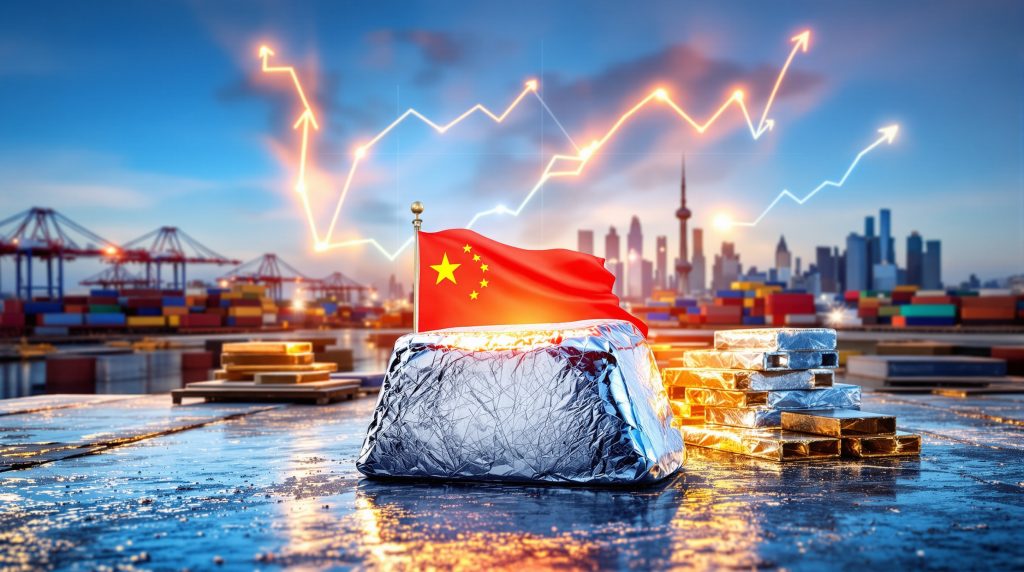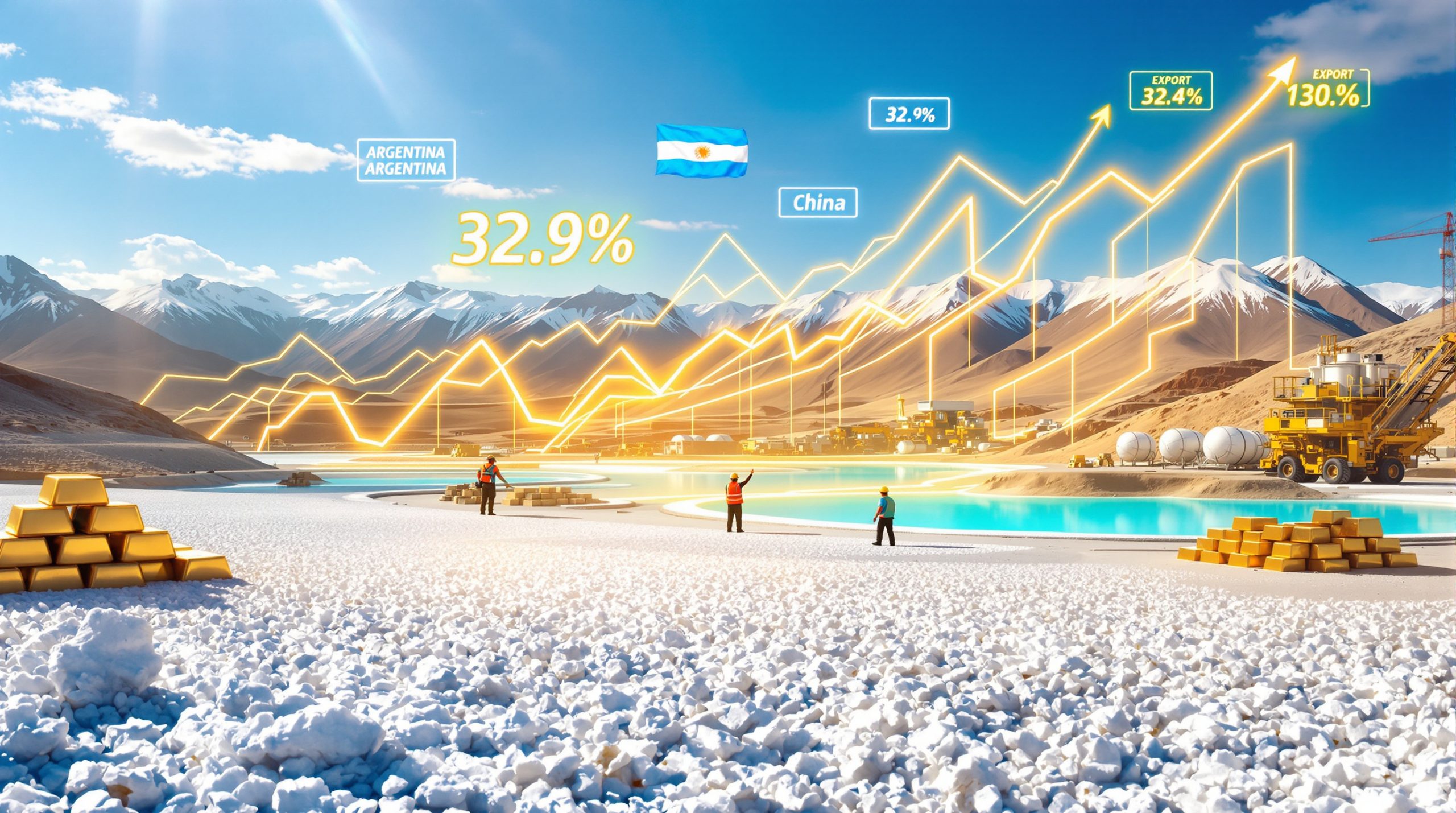China's Zinc Export Strategy: How Global Price Rallies Create Market Opportunities
The significant divergence between international and Chinese domestic zinc prices has created a rare arbitrage window for Chinese producers. While London Metal Exchange (LME) zinc prices have been climbing steadily since early 2025, Shanghai prices remain near their recent lows, creating favorable conditions for Chinese producers to export their surplus metal.
This price disconnect has opened up what industry experts call an "arbitrage window" – a profit opportunity arising from price differences between markets. The economic incentive is compelling enough that Chinese smelters are now preparing to ship refined zinc overseas, particularly to fabricators in Southeast Asia.
Market Dynamics Creating the Export Window
Price Disconnect Analysis: The core opportunity stems from LME zinc prices surging while Shanghai Futures Exchange (SHFE) prices remain relatively depressed. This divergence creates a profitable export pathway when the price gap exceeds the combined costs of transportation, insurance, and financing.
Backwardation Impact: Cash prices on the LME now exceed futures prices by the widest margin in three years. This market structure, known as backwardation, signals immediate physical metal scarcity in Western markets and further enhances export economics for Chinese producers.
Regional Market Imbalances: The fundamentals driving this situation reflect supply tightness in Western markets contrasting with Chinese oversupply. This two-speed market creates natural economic incentives for rebalancing through exports.
The export opportunity becomes viable when the price differential between markets exceeds approximately $150-200 per tonne, accounting for the 13% VAT export rebate available to Chinese producers and transportation costs of $50-80 per tonne to Southeast Asian destinations.
Historical Context for Chinese Zinc Exports
Previous Export Waves: The last significant zinc export surge from China occurred in 2022 following Russia's invasion of Ukraine. That geopolitical crisis triggered an energy price spike across Europe, forcing multiple zinc smelters to curtail production or shut down completely.
Energy Crisis Impact: During 2022, European natural gas prices skyrocketed to unprecedented levels, exceeding €300/MWh at their peak – more than ten times normal levels. Zinc smelting, requiring approximately 3,500 kWh per tonne of production, became economically unviable for many Western producers.
Market Rebalancing Patterns: Historical data shows China exported approximately 140,000-150,000 tonnes of zinc in 2022, with monthly shipments reaching 15,000-20,000 tonnes during peak periods. This export wave helped moderate global copper supply and ease physical supply constraints in Western markets.
The pattern of Chinese exports responding to international price signals demonstrates the increasingly integrated nature of global metals markets despite regional supply-demand imbalances.
What's Driving the Two-Speed Global Zinc Market?
The zinc market is experiencing a pronounced two-speed dynamic, with distinct supply-demand fundamentals in China compared to the rest of the world. This divergence explains why export opportunities have emerged despite generally subdued global economic conditions.
Chinese Domestic Market Conditions
Production Expansion: Chinese refined zinc output has continued to grow despite weak local demand. China now accounts for 40-45% of global refined zinc production, producing approximately 6.5-7 million tonnes annually, with smelting capacity approaching 8 million tonnes.
Demand Weakness Factors: China's prolonged property market downturn has severely impacted domestic zinc demand. The property sector accounts for roughly 30% of Chinese zinc consumption through galvanized steel usage, and property investment has been contracting since 2022, declining by 9.1% that year and continuing to struggle thereafter.
Inventory Accumulation: Rising stockpiles in Chinese warehouses have created selling pressure on domestic prices. SHFE zinc inventories more than doubled from approximately 70,000 tonnes to over 150,000 tonnes between early 2023 and mid-2025, while LME inventories followed the opposite trajectory.
Approximately 50% of global zinc consumption goes into galvanizing steel, making construction and infrastructure development critical demand drivers. The continued weakness in China's property sector has created a persistent oversupply situation domestically.
Western Market Supply Constraints
Smelter Production Cuts: Several major Western zinc refineries have reduced output in recent years. Notable examples include Glencore's Portovesme smelter in Italy (150,000 tonnes annual capacity) and Nyrstar's operations across Europe, which faced significant production cuts during energy price spikes.
Inventory Depletion: LME warehouse stocks have declined dramatically, falling from peaks of over 200,000 tonnes in early 2023 to below 80,000 tonnes by mid-2025. This inventory drawdown reflects persistent physical tightness in Western markets.
Physical Premium Development: Spot market premiums over exchange prices have risen in regions experiencing supply shortfalls. During tight supply periods, these premiums can reach $100-200 per tonne above LME prices, providing further incentive for Chinese exports.
The contrast between Chinese oversupply and Western shortfalls creates natural economic incentives for trade flows to rebalance the market – precisely what appears to be beginning now with Chinese export preparations.
How Much Zinc Could China Export in This Cycle?
Industry analysts and market participants provide varying estimates on potential export volumes based on current market conditions. The ultimate scale will depend on how long the arbitrage window remains open and how aggressively Chinese producers pursue overseas sales.
Export Volume Projections
Initial Testing Phase: According to Liu Yiting, analyst at Tianfeng Securities Co., "Some are testing export deals," with current shipments estimated at approximately 5,000 tons monthly due to relatively tepid overseas demand conditions. This suggests a cautious approach initially as producers test market receptivity.
Scaling Potential: If price differentials remain favorable, exports could potentially scale up significantly. Historical precedent from 2022 suggests monthly volumes could reach 15,000-20,000 tonnes during peak periods if market conditions warrant.
Logistical Considerations: For context, shipping 5,000 tonnes monthly would require approximately 225-250 container equivalents (based on standard 20-foot containers carrying 20-22 tonnes each). China's port infrastructure can easily accommodate much larger volumes if necessary.
Major Chinese zinc-exporting ports include Huangpu, Lianyungang, and Qingdao, with combined capacity for base metals exports exceeding 1 million tonnes annually. Regular container shipping services connect these ports to Southeast Asian destinations with transit times of 7-14 days.
Target Markets for Chinese Zinc
Southeast Asian Fabricators: Initial export shipments are reportedly targeting fabricators in Southeast Asia, according to traders familiar with the transactions. This region represents a logical first destination due to proximity and established trading relationships.
Regional Demand Assessment: Indonesia, Thailand, Vietnam, and Malaysia collectively consume approximately 500,000-600,000 tonnes of refined zinc annually. These markets traditionally source from Australia, Korea, and regional producers, with pricing typically at small premiums to LME.
Competitive Positioning: Chinese zinc can potentially displace traditional suppliers if offered at competitive prices. The 13% VAT rebate available to Chinese exporters provides significant pricing flexibility while still maintaining profitability.
The export strategy appears focused on markets where Chinese producers can establish footholds without disrupting pricing too dramatically, suggesting a strategic rather than purely opportunistic approach to international market development.
What Impact Will Chinese Exports Have on Global Zinc Prices?
The entry of Chinese zinc into international markets is expected to influence the recent price rally and potentially rebalance global supply. The magnitude of the impact will depend on export volumes and duration.
Price Impact Analysis
Rally Moderation Effects: Increased supply availability will likely cap further price gains on the LME. Historical patterns from 2022 show that following the export wave, LME zinc prices moderated from peaks above $4,000/tonne in April to below $3,000/tonne by late in the year.
Backwardation Reduction: The extreme backwardation currently observed in LME prices should gradually normalize as physical supply improves. Previous cycles show it typically takes 3-6 months for physical material flows to significantly impact price structures.
Regional Premium Adjustments: Physical delivery premiums in destination markets will likely decline as competition increases. Asian regional premiums, which typically range from $20-80/tonne depending on supply-demand balance, would be the first to respond.
Market rebalancing tends to occur gradually rather than abruptly, with price convergence between LME and SHFE developing over several months as arbitrage opportunities narrow.
Decoupling from Other Base Metals
Comparison with Copper: Alice Fox, commodities strategist at Macquarie Group Ltd., notes that zinc and copper price insights should decouple as the oversupply of zinc continues to build in China while copper faces mine disruptions. This analysis reflects fundamental differences in supply conditions between these metals.
Supply Fundamentals Contrast: While zinc faces potential oversupply through Chinese exports, copper markets remain tight due to mine production challenges. Copper was reportedly approaching all-time highs, highlighting this divergence in fundamentals.
Investment Sentiment Shifts: Traders and investors may reduce bullish positions in zinc while maintaining them in copper, further contributing to performance divergence between the two metals. Historically, copper and zinc prices show correlation coefficients of 0.6-0.7 over multi-year periods, but can decouple during supply-specific disruptions.
This potential divergence highlights the importance of understanding individual metal fundamentals rather than treating "base metals" as a homogeneous investment category.
How Does China's Zinc Strategy Fit Into Its Broader Metals Policy?
China's approach to zinc production and exports reflects its broader industrial and resource security priorities. The strategy demonstrates a consistent pattern seen across China's metals sector.
Strategic Metals Management
Security of Supply Focus: China's smelters have continued operating despite lower margins, reflecting Beijing's prioritization of production capacity over short-term profitability. This approach ensures domestic supply security while maintaining operational readiness for export opportunities.
State-Affiliated Smelter Role: Approximately 70-80% of China's zinc smelting capacity is controlled by state-owned or state-affiliated enterprises. Major producers include Zhuzhou Smelter Group (state-owned), Shaanxi Dongling Group, and Yunnan Chihong Zinc & Germanium (partially state-affiliated).
Market Share Expansion: Chinese zinc production grew from approximately 3 million tonnes in 2005 to over 6.5 million tonnes by 2023, a pattern mirrored in aluminum (now 60% of global supply) and copper cathode (40% of global refined production). This consistent expansion demonstrates China's strategic approach to metals production.
This trend of expanding market influence has been consistent across multiple metals, with China now dominating global production in aluminum, steel, zinc, lead, and many other industrial metals. The US-China trade war impact on these metals markets has further complicated the global supply picture.
Policy Balancing Considerations
Domestic Industry Protection: Chinese authorities typically ensure sufficient local supply before encouraging exports. The current export push suggests officials are comfortable with domestic market balance despite property sector weakness.
Value-Added Processing: China restricts exports of zinc concentrates while encouraging refined metal exports through VAT rebates. Zinc concentrate exports face 0% VAT refund, while refined zinc receives 13% VAT rebate, incentivizing domestic processing to capture more value within China.
Environmental Compliance Factors: China's zinc smelters must comply with increasingly strict emissions standards under national environmental policies. Newer facilities incorporate advanced environmental controls, potentially affecting cost competitiveness in international markets.
This balanced approach aims to maximize industrial value creation while maintaining supply security and gradually improving environmental performance – core objectives of China's broader industrial policy. Additionally, the tariff impact on investments in the metals sector has influenced how producers position themselves globally.
What Are the Key Indicators to Watch for Zinc Market Developments?
Several market metrics will signal the progression and impact of Chinese zinc exports on global markets. These indicators provide valuable forward guidance for market participants.
Critical Market Signals
Price Arbitrage Spread: The LME-SHFE price spread serves as the primary driver of export economics. Spreads exceeding 10% historically trigger sustained arbitrage activity if maintained for several weeks. Current monitoring should focus on whether spreads narrow or widen from present levels.
Physical Premiums Trajectory: Regional delivery premiums over exchange prices provide real-time feedback on physical market tightness. A decline in these premiums would indicate improving supply conditions in destination markets.
Inventory Movements: Shifts in warehouse stocks across LME and SHFE storage locations offer tangible evidence of market rebalancing. Rising LME inventories coupled with declining SHFE stocks would confirm the export trend is materially impacting supply distribution.
Currency fluctuations (USD/CNY exchange rates) also impact arbitrage economics, with exchange rate volatility affecting export profitability. A strengthening yuan would reduce export incentives, while depreciation would enhance them.
Trade Flow Monitoring Points
Export License Approvals: Chinese zinc exports require licenses from the Ministry of Commerce for quantities exceeding certain thresholds. The license approval timeline typically spans 2-4 weeks, providing a forward indicator of export intentions.
Shipping Bookings Data: Maritime intelligence services track vessel bookings, offering advance notice of physical shipments. Increasing bookings for China-Southeast Asia routes would confirm export momentum.
Destination Market Price Reactions: Local price adjustments in importing regions provide feedback on market absorption capacity. Significant price declines in destination markets might indicate oversupply developing.
Additional leading indicators include smelter operating rates published by China Nonferrous Metals Industry Association, zinc concentrate import volumes, and forward freight rates for China-Southeast Asia routes. The evolution of mining industry trends also provides context for these developments.
FAQ: China's Zinc Export Strategy
What factors are driving the divergence between global and Chinese zinc prices?
The price disconnect stems from contrasting market conditions: Western markets face production cuts and inventory depletion, while China experiences growing output and relatively weak domestic demand, particularly from its struggling property sector which traditionally drives galvanized steel consumption.
China's property investment declined by 9.1% in 2022 and continued contracting through subsequent years, severely impacting local zinc demand. Meanwhile, European energy crises and operational challenges at Western smelters created supply constraints outside China, driving international prices higher.
How significant could Chinese zinc exports become in 2025?
Initial estimates suggest modest volumes around 5,000 tons monthly during the testing phase, with potential for growth depending on arbitrage opportunities and overseas demand strength. Previous export cycles have seen volumes reach tens of thousands of tons monthly when economic conditions were favorable.
The 2022 precedent saw China export approximately 140,000-150,000 tonnes annually, with monthly volumes reaching 15,000-20,000 tonnes during peak periods. Current conditions suggest a more measured approach initially, but volumes could accelerate if price differentials remain attractive.
Will Chinese exports completely halt the global zinc price rally?
While Chinese exports are expected to moderate the recent price surge, they may not completely reverse it if physical tightness in Western markets persists. The exports will likely cap further gains and reduce the extreme backwardation currently seen in LME prices.
Previous market rebalancing cycles have taken 3-6 months to significantly impact price structures as physical material moves and market participants adjust positions. Price convergence between LME and SHFE typically occurs gradually as arbitrage opportunities narrow.
How does China's approach to zinc compare with its strategy for other metals?
China's zinc strategy follows a similar pattern seen across its metals sector, where state-affiliated producers prioritize market share and supply security over short-term profitability. This approach has successfully expanded China's influence in global markets for copper, aluminum, and other base metals.
China now accounts for approximately 40-45% of global refined zinc production, 60% of aluminum, and 40% of copper cathode. This consistent pattern of production growth regardless of short-term market conditions reflects strategic priorities rather than purely commercial considerations.
Market Outlook: Balancing Global Zinc Supply and Demand
The emergence of Chinese zinc exports represents a natural market response to price differentials and will likely contribute to rebalancing global supply distribution in coming months.
Short-Term Market Adjustments
Price Convergence Expectations: The gap between Chinese and international prices should gradually narrow as export volumes increase. This convergence may occur through both moderation of LME prices and potential strengthening of SHFE prices.
Trade Flow Redistribution: Southeast Asian markets will likely see increasing Chinese zinc shipments, potentially displacing traditional suppliers from Australia, Korea, and elsewhere. This shift may cascade through regional supply chains as displaced metal seeks alternative destinations.
Producer Response Outside China: Non-Chinese producers may adjust production plans or sales strategies in response to increased competition. Those with flexible capacity might reduce output if margins deteriorate significantly.
Market participants should anticipate a 3-6 month adjustment period as physical flows reorient and price relationships normalize. The pace of this adjustment will depend on both export volumes and broader economic conditions affecting demand.
Longer-Term Structural Considerations
Chinese Production Capacity Growth: China's zinc refining industry continues expanding despite periodic market imbalances. This structural trend suggests China will maintain its dominant position in global zinc production regardless of short-term export fluctuations.
Global Demand Recovery Potential: Economic recovery in key consuming sectors like construction, automotive, and infrastructure development could strengthen zinc consumption outside China. Such demand improvement would help absorb increased supply without dramatic price deterioration.
Investment Implications: Changing trade patterns may affect producer profitability and investment decisions throughout the zinc supply chain. Western producers facing increased competition may delay capacity expansions, while Chinese producers could gain confidence to pursue further growth.
The cyclical nature of these export windows suggests the current situation represents an adjustment phase rather than a permanent structural shift. Nevertheless, each cycle tends to further cement China's central position in global metals markets.
Want to Catch Major Mineral Discoveries as They Happen?
Discovery Alert's proprietary Discovery IQ model delivers instant notifications on significant ASX mineral discoveries, transforming complex data into actionable investment insights. Explore how major discoveries can generate substantial returns by visiting Discovery Alert's dedicated discoveries page and position yourself ahead of the market.




